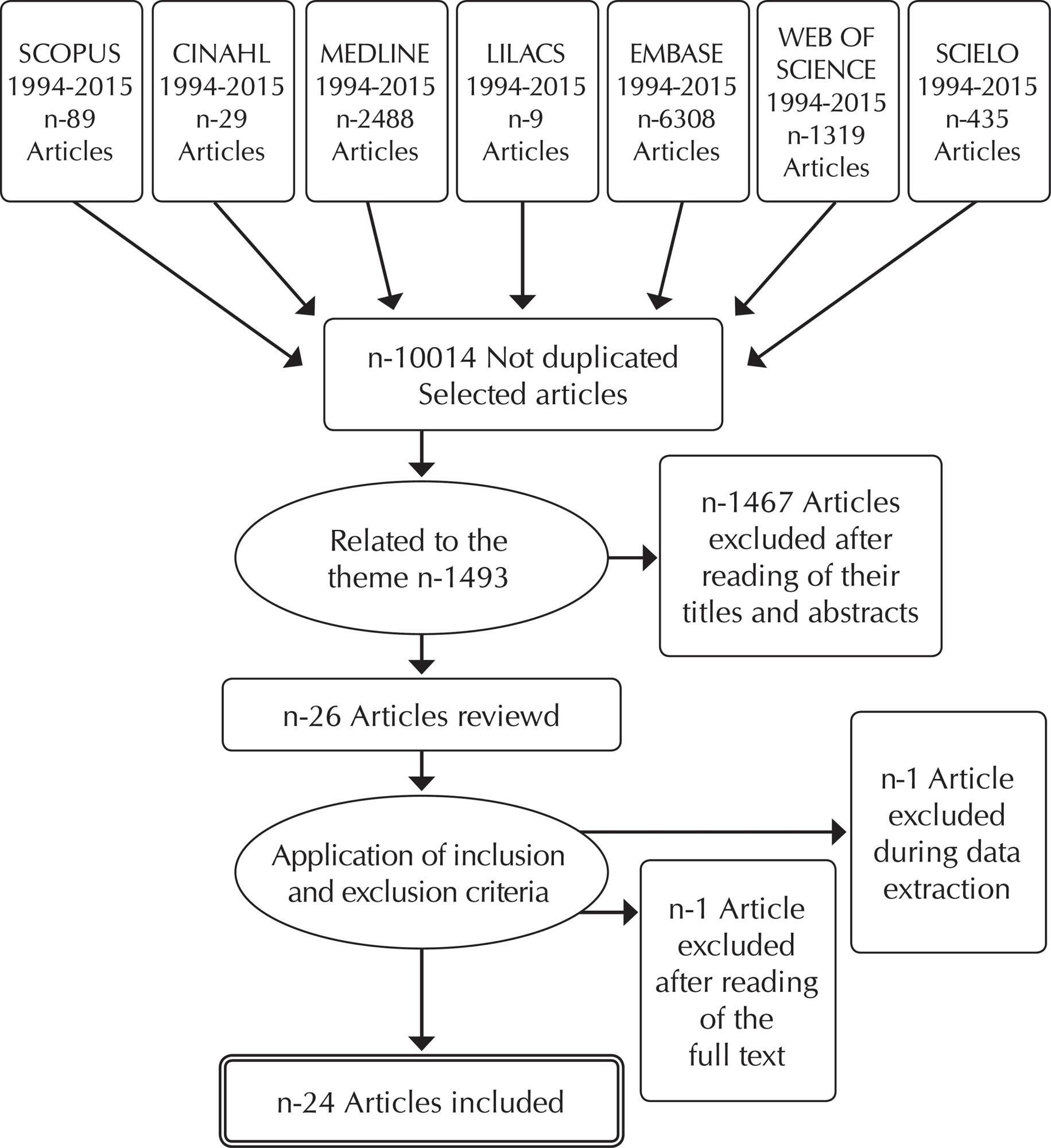-
REFLECTION01-01-2017
Transcendence, historicity and temporality of being elderly: nursing reflection-using Heidegger
Revista Brasileira de Enfermagem. 2017;70(4):891-895
Abstract
REFLECTIONTranscendence, historicity and temporality of being elderly: nursing reflection-using Heidegger
Revista Brasileira de Enfermagem. 2017;70(4):891-895
DOI 10.1590/0034-7167-2016-0275
Views0See moreABSTRACT
The objective is to reflect on historicity and temporality as paths for the transcendence of being elderly, based on the phenomenological concepts of Martin Heiddeger. A review of the concepts of transcendence, historicity and temporality was carried out in the work of Martín Heidegger, integrating them in the perspective of nursing for the elderly. The transcendence of the elderly adult is feasible by accessing the temporality of self in the path of its historicity to arrive at the understanding of itself that he has achieved: transcending, which is but a process of the Being itself. Being is time in itself existing in the world, existence given by the encounter of the past (to have been), present and future (becoming), the same encounter that determines the historicity of the Being. The encounter has been consummated and the Being is transcendence, with the understanding of the Being itself as a supreme point.
-
EXPERIENCE REPORT01-01-2017
Acercamiento al escenario de estudio fenomenológico en México: relato de experiencia
Revista Brasileira de Enfermagem. 2017;70(4):885-890
Abstract
EXPERIENCE REPORTAcercamiento al escenario de estudio fenomenológico en México: relato de experiencia
Revista Brasileira de Enfermagem. 2017;70(4):885-890
DOI 10.1590/0034-7167-2016-0601
Views0See moreRESUMEN
Objetivo:
Relatar la experiencia del acercamiento al escenario de un estudio fenomenológico en enfermería en México.
Método:
Relato de experiencia sobre el acercamiento al escenario de estudio para convivir con adultos mayores con la finalidad de seleccionar a los participantes de un estudio fenomenológico.
Resultados:
Se llevaron a cabo visitas durante el año 2016, en un periodo de cuatro meses a dos grupos de adultos mayores en donde se realizaron diversas actividades. La convivencia con los adultos mayores a través del acompañamiento en las actividades que realizaban en los grupos y el diálogo conjunto permitió seleccionar a aquellos que respondían a las características del objeto de estudio.
Conclusión:
Es necesaria la aproximación al escenario de estudios fenomenológicos, no sólo con la finalidad de ganar empatía de los participantes sino para sumergirse en el fenómeno de estudio, mismo que se va mostrando desde los primeros acercamientos del investigador.
-
EXPERIENCE REPORT01-01-2017
Scenario approximation in a phenomenological study in Mexico: experience report
Revista Brasileira de Enfermagem. 2017;70(4):885-890
Abstract
EXPERIENCE REPORTScenario approximation in a phenomenological study in Mexico: experience report
Revista Brasileira de Enfermagem. 2017;70(4):885-890
DOI 10.1590/0034-7167-2016-0601
Views0See moreABSTRACT
Objective:
To report our experience using scenario approximation in a phenomenological study of nursing in Mexico.
Method:
Experience report on scenario approximation to coexist with elderly in order to select the participants of a phenomenological study.
Results:
During a four-month period in 2016, visits were carried out two groups of elderly individuals where several activities were carried out. Coexistence with the elderly throughout accompaniment in the groups’ activities together with joint dialogue allowed selection of those who corresponded to the characteristics of the study objective.
Conclusion:
Scenario approximation is necessary in phenomenological studies, not only for creating empathy among the participants but also for the researchers to immerse themselves in the phenomenon under study, as shown by the first approaches of the researcher.
-
REVIEW01-01-2017
Functional health literacy and adherence to the medication in older adults: integrative review
Revista Brasileira de Enfermagem. 2017;70(4):868-874
Abstract
REVIEWFunctional health literacy and adherence to the medication in older adults: integrative review
Revista Brasileira de Enfermagem. 2017;70(4):868-874
DOI 10.1590/0034-7167-2016-0625
Views1See moreABSTRACT
Objective:
to characterize the national and international scientific production on the relationship of Functional Health Literacy and the adherence to the medication in older adults.
Method:
integrative review of literature, searching the following online databases: Scientific Electronic Library Online (SCIELO); Latin American and Caribbean Health Sciences Literature (LILACS); Medical Literature Analysis and Retrieval System Online (MEDLINE); and Cumulative Index to Nursing & Allied Health Literature (CINAHL), in June 2016. We selected 7 articles that obeyed the inclusion criteria.
Results:
all articles are from the USA. The inappropriate Functional Health Literacy affects the non-adherence to medication; however, there are several strategies and interventions that can be practiced to change this relationship.
Conclusion:
nursing needs to explorefurther this theme, since it can exert a differentiated care for adherence to medication in older adults, considering the literacy.
-
RESEARCH01-01-2017
Evaluation of the safety of hospitalized older adults as for the risk of falls
Revista Brasileira de Enfermagem. 2017;70(4):860-867
Abstract
RESEARCHEvaluation of the safety of hospitalized older adults as for the risk of falls
Revista Brasileira de Enfermagem. 2017;70(4):860-867
DOI 10.1590/0034-7167-2017-0098
Views0See moreABSTRACT
Objective:
To evaluate the safety of hospitalized older adults as for the risk of falls according to the parameters of the Morse Fall Scale.
Method:
Epidemiological, cross-sectional, prospective and descriptive study with n=75.
Results:
Average age of 71.3 years (SD±8.2); 58.7% male; 44% with low educational level; 38.7% hospitalized for cardiovascular diseases; average hospitalization of 10 days (SD±9.38); 78.7% with comorbidities; 61.3% with the calf circumference ≥ 31 cm; 62.7% were former smokers for more than 10 years; 65% did not drink alcohol; 100% did not have identification bracelet; 22.7% had similar names in the infirmary; 48% took up to five medicines; and 93.3% received some invasive procedure, especially the vessel puncture (65.3%). There was a high risk of falls in 52% of older adults.
Conclusion:
The results pointed to imminent risk of breach of patient safety, emphasizing the need for implementation of protocols and predictive scales such as the Morse scale.
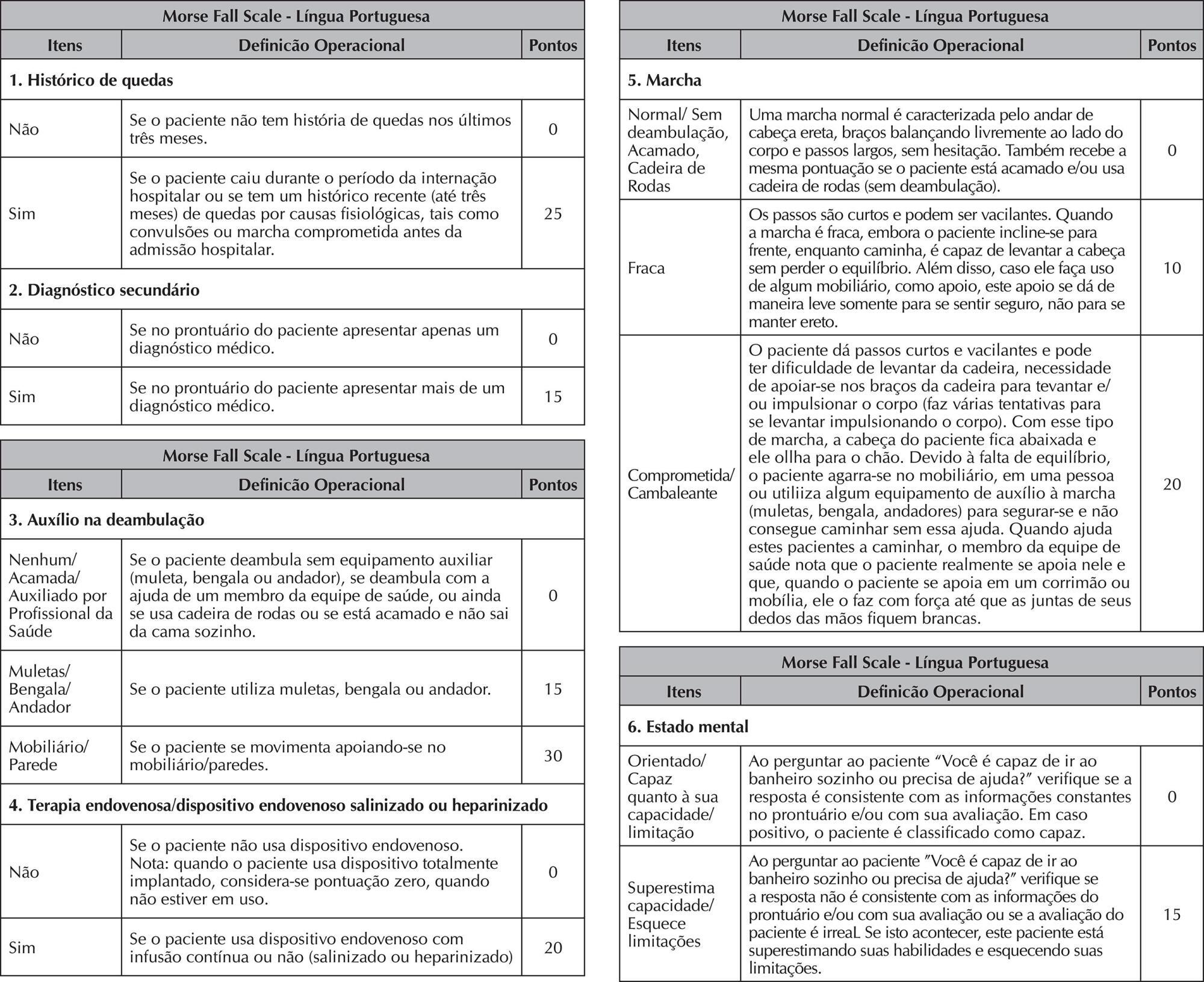
-
RESEARCH01-01-2017
Quality of life of elderly people with chronic kidney disease in conservative treatment
Revista Brasileira de Enfermagem. 2017;70(4):851-859
Abstract
RESEARCHQuality of life of elderly people with chronic kidney disease in conservative treatment
Revista Brasileira de Enfermagem. 2017;70(4):851-859
DOI 10.1590/0034-7167-2017-0103
Views0See moreABSTRACT
Objective:
To describe the quality of life (QOL) of elderly people with Chronic Kidney Disease (CKD) in conservative treatment, correlating it with sociodemographic and health-related aspects.
Method:
This is a quantitative, cross-sectional, and descriptive study that used: a previously validated instrument for data collection; the WHOQOL-BREF and WHOQOL-OLD QOL scales; and the Mini-Mental State Examination.
Results:
Thirty-five elderly people (54.30% females), with mean age of 68.26 years, took part in the study. They reported, on average, 3.70 comorbidities and 5.60 complications related to CKD. Regarding QOL, the “psychological” domain (54.40±16.29) and the “death and dying” facet (37.32±23.79) were considered the most damaged ones; the most strengthened were “social relationships” (70.36±18.32) and “intimacy” (66.61±16.80). A positive correlation was verified between comorbidities and complications (p = 0.015), and an inverse correlation between the number of complications and QOL (p = 0.004).
Conclusion:
These results, if considered during the care planning, may help improving the quality of the care provided for elderly people with CKD.
-
RESEARCH01-01-2017
Hospitalization of people 50 years old or older living with HIV/AIDS
Revista Brasileira de Enfermagem. 2017;70(4):845-850
Abstract
RESEARCHHospitalization of people 50 years old or older living with HIV/AIDS
Revista Brasileira de Enfermagem. 2017;70(4):845-850
DOI 10.1590/0034-7167-2017-0113
Views0See moreABSTRACT
Objective:
Identify the rate and predictive factors of the hospitalization of people living with HIV/AIDS (PLHA), aged 50 years or older.
Method:
A quantitative, cross-sectional study was conducted at two inpatient units specialized in infectious diseases in a teaching hospital. Data were gathered through individual interviews between August 2011 and February 2015. All ethical precepts were followed.
Results:
Of the 532 admitted patients, 95 were PLHA 50 years old or older; 30.5% were admitted 3 to 4 times after being diagnosed with HIV/AIDS.
Conclusion:
Rate of hospitalization was 17.8%, and being 50 to 60 years old was a protective factor against hospitalization.
-
ORIGINAL ARTICLE12-04-2023
Effect of cardiovascular biofeedback on nursing staff stress: a randomized controlled clinical trial
Revista Brasileira de Enfermagem. 2023;76(6):e20230069
Abstract
ORIGINAL ARTICLEEffect of cardiovascular biofeedback on nursing staff stress: a randomized controlled clinical trial
Revista Brasileira de Enfermagem. 2023;76(6):e20230069
DOI 10.1590/0034-7167-2023-0069
Views0See moreABSTRACT
Objective:
to assess the effect of cardiovascular biofeedback on nursing staff stress when compared to an activity without self-monitoring.
Method:
a randomized controlled clinical trial, carried out with nursing professionals from a university hospital. The intervention group (n=58) performed cardiovascular biofeedback, and the control (n=57) performed an online puzzle without self-monitoring, totaling nine meetings over three weeks. The outcome was assessed using the Stress Symptoms and Work-Related Stress scales, and the biological marker heart rate variability. The generalized estimating equations method was used.
Results:
the intervention had no effect on self-reported instruments (p>0.050). However, there was an effect of time (p<0.050) on all heart rate variability indicators, demonstrating changes over the sessions.
Conclusion:
cardiovascular biofeedback showed promising results in the biological marker, suggesting that it can be used in nursing staff as a complementary therapy by promoting better autonomic nervous system regulation.
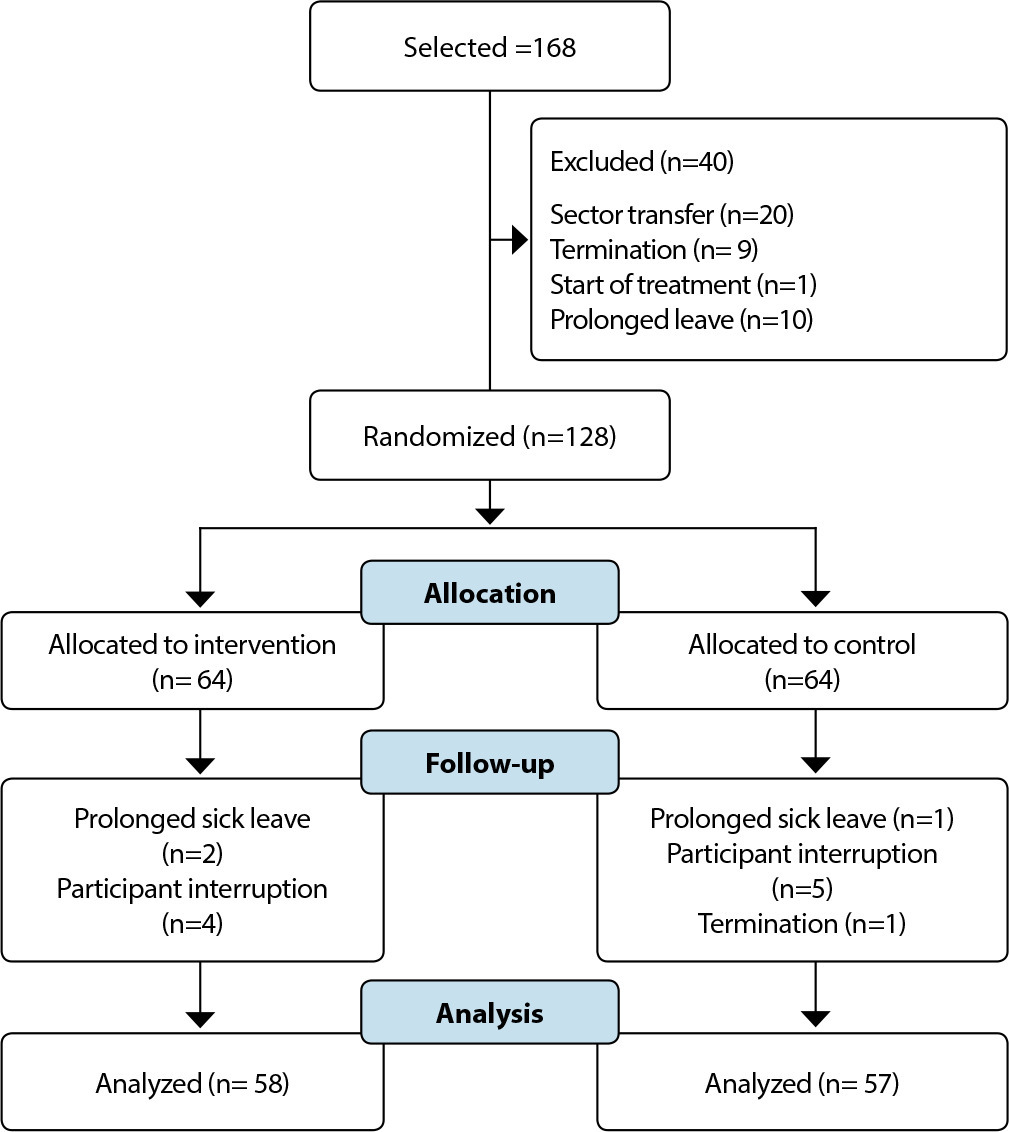
-
Transition of Care for Individuals with Mental Disorders in Brazil: A Contextual Analysis
Revista Brasileira de Enfermagem. 2023;76(6):e20230063
Abstract
Transition of Care for Individuals with Mental Disorders in Brazil: A Contextual Analysis
Revista Brasileira de Enfermagem. 2023;76(6):e20230063
DOI 10.1590/0034-7167-2023-0063
Views0See moreABSTRACT
Objective:
To describe the contexts of care transition for individuals with mental disorders in the Brazilian setting.
Methods:
A contextual analysis was conducted through a scoping review. The search for studies was conducted in databases and thesis and dissertation portals, and the analysis was based on immediate, specific, general, and meta-contexts.
Results:
The sample, consisting of eight studies, indicated that the following factors are present in the contexts where care transition occurs: Peculiarities of care transition for individuals with mental disorders; Perspectives that can strengthen or weaken this transition; Approaches proposed in the past for the development of care transition; and Elements related to Brazilian legislation.
Final Considerations:
It is observed that the transition of care for individuals with mental disorders in Brazil takes place in various contexts of care levels. These variations present significant potentials and barriers in the care scenarios.
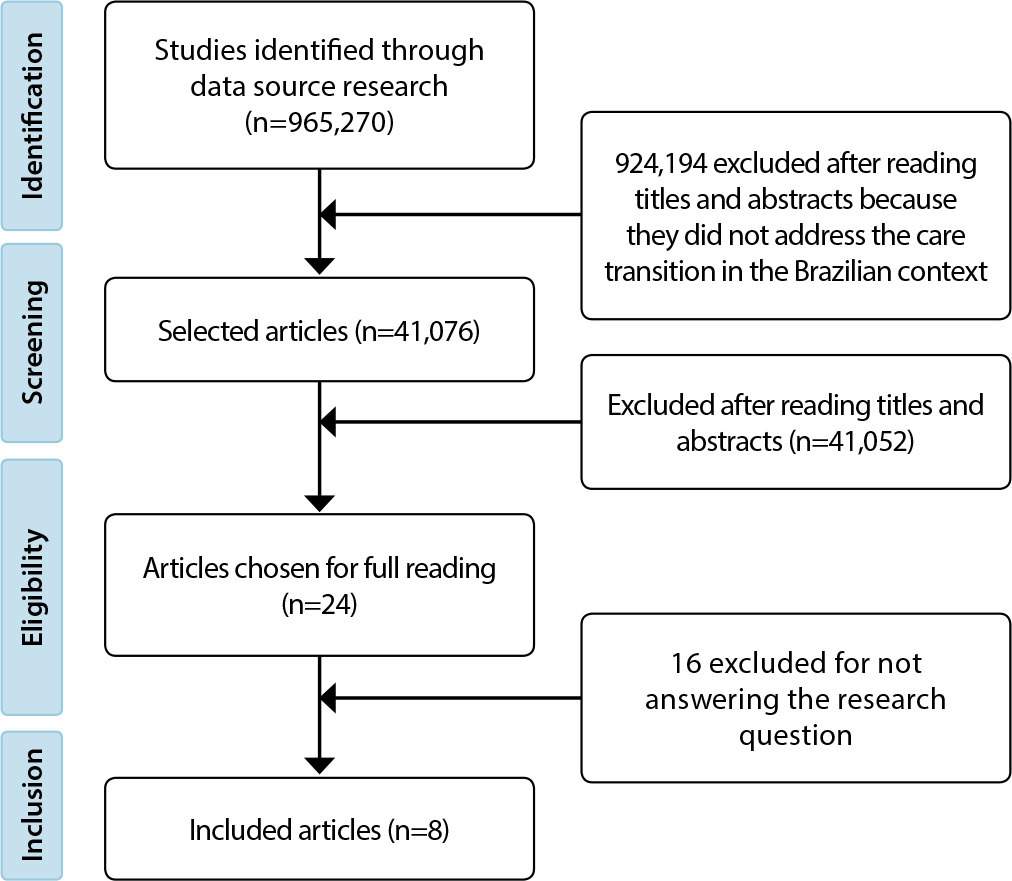
-
ORIGINAL ARTICLE12-04-2023
Feelings about birth by a group of high-risk pregnant women
Revista Brasileira de Enfermagem. 2023;76(6):e20230059
Abstract
ORIGINAL ARTICLEFeelings about birth by a group of high-risk pregnant women
Revista Brasileira de Enfermagem. 2023;76(6):e20230059
DOI 10.1590/0034-7167-2023-0059
Views0See moreABSTRACT
Objective:
to understand feelings about birth among a group of high-risk pregnant women.
Method:
a descriptive and qualitative study, using Alfred Schütz’s social phenomenology as a philosophical theoretical framework. The study included 25 pregnant women undergoing high-risk prenatal care. The interview had the following guiding questions: tell me about your feelings regarding the moment of birth/childbirth; How do you deal with the high-risk diagnosis? What are your expectations for birth/childbirth?
Results:
five categories emerged: Fear of obstetric care; Fear of complications with the baby; Fear of cesarean section; Resilience in the face of high-risk pregnancy; and Expectations for birth.
Considerations:
high-risk pregnant women are afraid of the care they will receive, the risks and concern about the baby’s vitality at birth. The importance of care is emphasized, with a welcoming environment, bonding and communication between health team and pregnant woman.
-
ORIGINAL ARTICLE12-04-2023
Sobrecarga entre cuidadores cônjuges e não cônjuges de idosos dependentes por AVC: estudo longitudinal
Revista Brasileira de Enfermagem. 2023;76(6):e20230052
Abstract
ORIGINAL ARTICLESobrecarga entre cuidadores cônjuges e não cônjuges de idosos dependentes por AVC: estudo longitudinal
Revista Brasileira de Enfermagem. 2023;76(6):e20230052
DOI 10.1590/0034-7167-2023-0052
Views0See moreRESUMEN
Objetivo:
evaluar la carga de los cuidadores conyugales y no conyugales de ancianos con dependencia inducida por ictus después del alta de la Unidad de Atención Especializada en Ictus de un hospital del sur de Brasil.
Métodos:
una encuesta longitudinal, con 48 cuidadores (20 cónyuges). Datos fueron recolectados entre mayo/2016 y julio/2018. Una semana después del alta, se aplicó la Medida de Independencia Funcional a los ancianos y la Caregiver Burden Scale a los cuidadores. Los datos se analizaron mediante análisis multivariado de varianza.
Resultados:
en tiempo 1, los cónyuges experimentaron mayor carga en relación al aislamiento social (p=0,01). Los cónyuges sintieron una tensión general y sensación de aislamiento mucho mayor (p=0,01; p=0,04).
Conclusión:
las diferencias estadísticamente significativas en la carga a lo largo del tiempo resaltan la importancia de evaluar la carga del cuidador después del alta y la necesidad de un programa de apoyo formal.
-
ORIGINAL ARTICLE12-04-2023
A longitudinal study of burden among spouse and non-spouse caregivers of older adults with stroke-induced-dependency
Revista Brasileira de Enfermagem. 2023;76(6):e20230052
Abstract
ORIGINAL ARTICLEA longitudinal study of burden among spouse and non-spouse caregivers of older adults with stroke-induced-dependency
Revista Brasileira de Enfermagem. 2023;76(6):e20230052
DOI 10.1590/0034-7167-2023-0052
Views0See moreABSTRACT
Objective:
to assess the burden of spouse and non-spouse caregivers of older adults with stroke-induced-dependency after discharge from a university hospital’s Specialized Care Stroke Unit in southern Brazil.
Methods:
a longitudinal survey. The sample consisted of 48 consenting caregivers, among which 20 were spouse caregivers. Data were collected between May 2016 and July 2018. One week after discharge, caregivers completed a sociodemographic profile, the Functional Independence Measure, and the Caregiver Burden Scale. Burden was also measured two months after discharge. Data were analyzed using Multivariate Analyses of Variance.
Results:
regarding time 1, non-spouse caregivers experienced greater burden with respect to social isolation (p = .01). Along with a persistently greater sense of isolation (p=.04), non-spouse caregivers felt far greater general strain (p =.01).
Conclusion:
statistically significant differences in burden over time highlight the importance of assessing caregiver burden after discharge and the need for a formal support program.
-
Simulation training of caregivers at hospital discharge of patients with chronic diseases: an integrative review
Revista Brasileira de Enfermagem. 2023;76(6):e20230043
Abstract
Simulation training of caregivers at hospital discharge of patients with chronic diseases: an integrative review
Revista Brasileira de Enfermagem. 2023;76(6):e20230043
DOI 10.1590/0034-7167-2023-0043
Views0See moreABSTRACT
Objective:
to identify evidence about the use and effects of clinical simulation for preparing caregivers for discharging patients with chronic conditions.
Methods:
an integrative peer review in the Scopus, PubMed, Web of Science, Cumulative Index to Nursing and Allied Health Literature, ScienceDirect and Virtual Health Library databases, from July to September 2022.
Results:
3,218 studies were identified, with a final sample consisting of four national and two international articles. Using simulation as an educational technology contributed to caregiver preparation in home care. In most studies, using clinical simulation included using other strategies to complement training: expository dialogued class, conversation circle and audiovisual resources.
Final considerations:
simulation proved to be efficient for training caregivers, with the active participation of family members and nurses in health education actions.
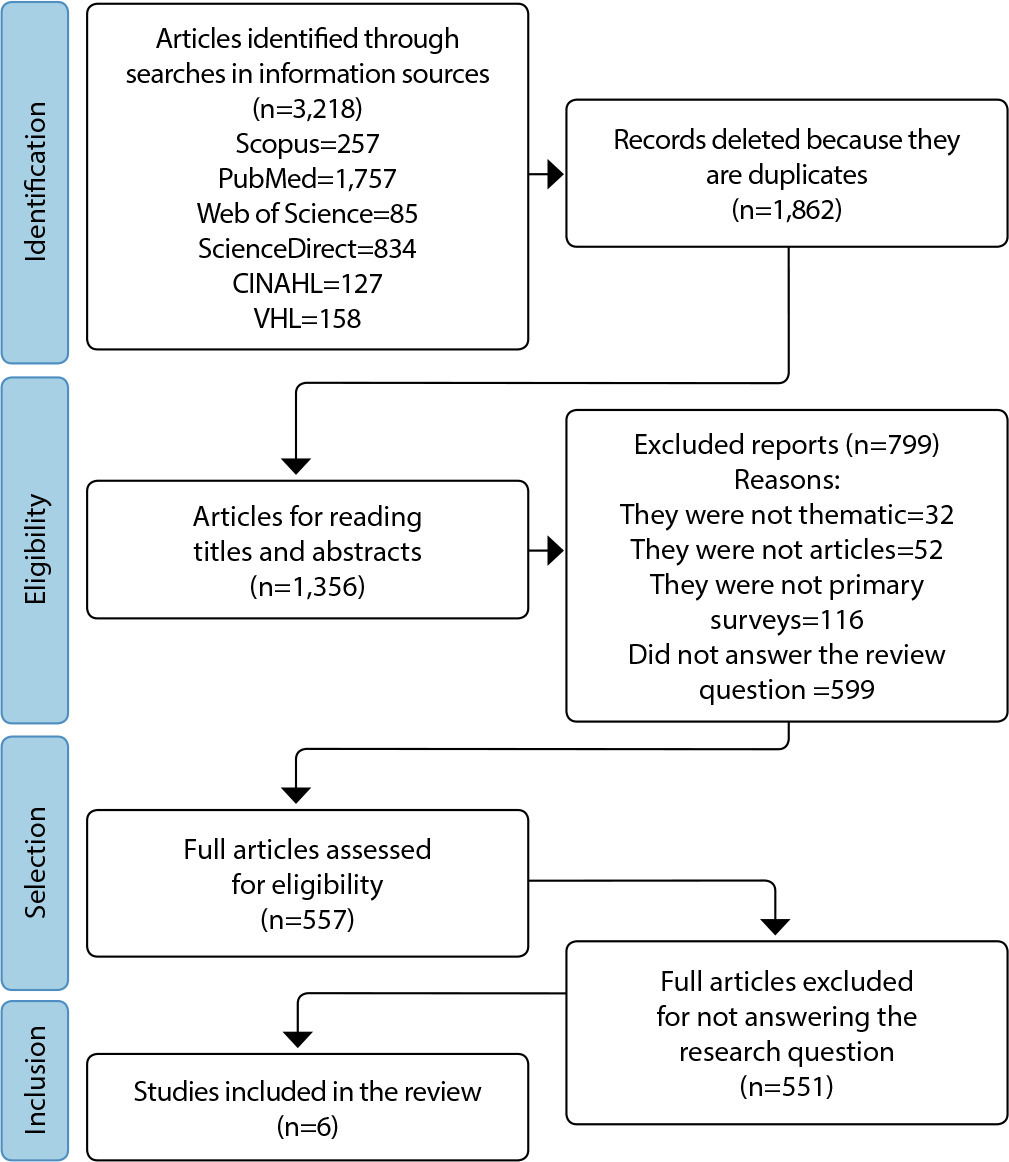
-
ORIGINAL ARTICLE12-04-2023
Alterações na composição corporal de pacientes queimados durante as fases de resposta ao trauma
Revista Brasileira de Enfermagem. 2023;76(6):e20230039
Abstract
ORIGINAL ARTICLEAlterações na composição corporal de pacientes queimados durante as fases de resposta ao trauma
Revista Brasileira de Enfermagem. 2023;76(6):e20230039
DOI 10.1590/0034-7167-2023-0039
Views0RESUMEN
Objetivo:
evaluar alteraciones en la composición corporal de pacientes quemados mediante bioimpedancia eléctrica en las fases de respuesta al trauma.
Métodos:
estudio observacional longitudinal, realizado de octubre de 2019 a marzo de 2020. Se recogieron datos sociodemográficos, clínicos, epidemiológicos, antropométricos y de composición corporal. El análisis estadístico se realizó mediante SPSS, considerando una significancia del 5%. La comparación entre variables se realizó mediante la prueba de la t de Student pareada.
Resultados:
la muestra estuvo compuesta por 58 pacientes adultos quemados, con una edad media de 38,2±12,5 años. El área de superficie corporal media (ASC) con quemaduras fue de 10,8±7,3%. La evaluación nutricional mostró disminución del peso corporal, índice de masa corporal, masa magra y masa muscular en las fases de respuesta al trauma (p<0,005).
Conclusión:
los cambios metabólicos en las diferentes fases de la respuesta metabólica al trauma llevaron a la disminución del estado nutricional de los pacientes quemados de ambos sexos durante la hospitalización.
Keywords:Avaliação NutricionalComposição CorporalEstado NutricionalImpedância BioelétricaQueimadurasSee more -
ORIGINAL ARTICLE12-04-2023
Changes in body composition of burn patients during the phases of response to trauma
Revista Brasileira de Enfermagem. 2023;76(6):e20230039
Abstract
ORIGINAL ARTICLEChanges in body composition of burn patients during the phases of response to trauma
Revista Brasileira de Enfermagem. 2023;76(6):e20230039
DOI 10.1590/0034-7167-2023-0039
Views0See moreABSTRACT
Objective:
To assess the changes in body composition of burn patients through electrical bioimpedance in the phases of response to trauma.
Methods:
a longitudinal observational study, carried out from October 2019 to March 2020. Sociodemographic, clinical, epidemiological, anthropometric and body composition data were collected. Statistical analysis was performed with SPSS, considering a significance of 5%. The comparison between variables was performed using the paired Student’s t test.
Results:
the sample consisted of 58 adult burn patients, with a mean age of 38.2±12.5 years. The mean body surface area (BSA) with burns was 10.8±7.3%. Nutritional assessment demonstrated a depletion of body weight, Body Mass Index, fat-free mass and muscle mass in the phases of response to trauma (p<0.005).
Conclusion:
metabolic alterations in the different phases of the metabolic response to trauma led to a depletion of the nutritional status of burn patients of both sexes during hospitalization.
-
ORIGINAL ARTICLE01-10-2024
Childbirth dynamics in the riverside region of the Brazilian Amazon from the perspective of geospatialization
Revista Brasileira de Enfermagem. 2024;77:e20240038
Abstract
ORIGINAL ARTICLEChildbirth dynamics in the riverside region of the Brazilian Amazon from the perspective of geospatialization
Revista Brasileira de Enfermagem. 2024;77:e20240038
DOI 10.1590/0034-7167-2024-0038
Views0See moreABSTRACT
Objective:
to analyze the spatial-temporal pattern of childbirths and flow of postpartum women assisted at a regional reference maternity hospital.
Methods:
ecological study of 4,081 childbirths, between September 2018 and December 2021, at a public maternity hospital in the Baixo Tocantins region, Pará, Brazil. With data collected from five sources, a geographic database was constructed, and spatial analysis was used with Kernel density interpolator. Maps were generated using QGis/3.5 and TerraView/4.3, calculating chi-square (p<0.05).
Results:
the highest concentrations of normal and cesarean childbirths were observed in Barcarena (n=2,558/62.68%), Abaetetuba (n=750/18.38%), Moju (n=363/8.89%) and Igarapé-Miri (n=219/5.37%). Among the municipalities in the region, ten had obstetric beds, totaling 210 beds. In this scenario, postpartum women traveled up to 288 km to reach the maternity hospital.
Conclusions:
long distances between certain municipalities of residence and maternity hospital, and low supply of obstetric beds, were identified as risk factors for unfavorable obstetric outcomes.
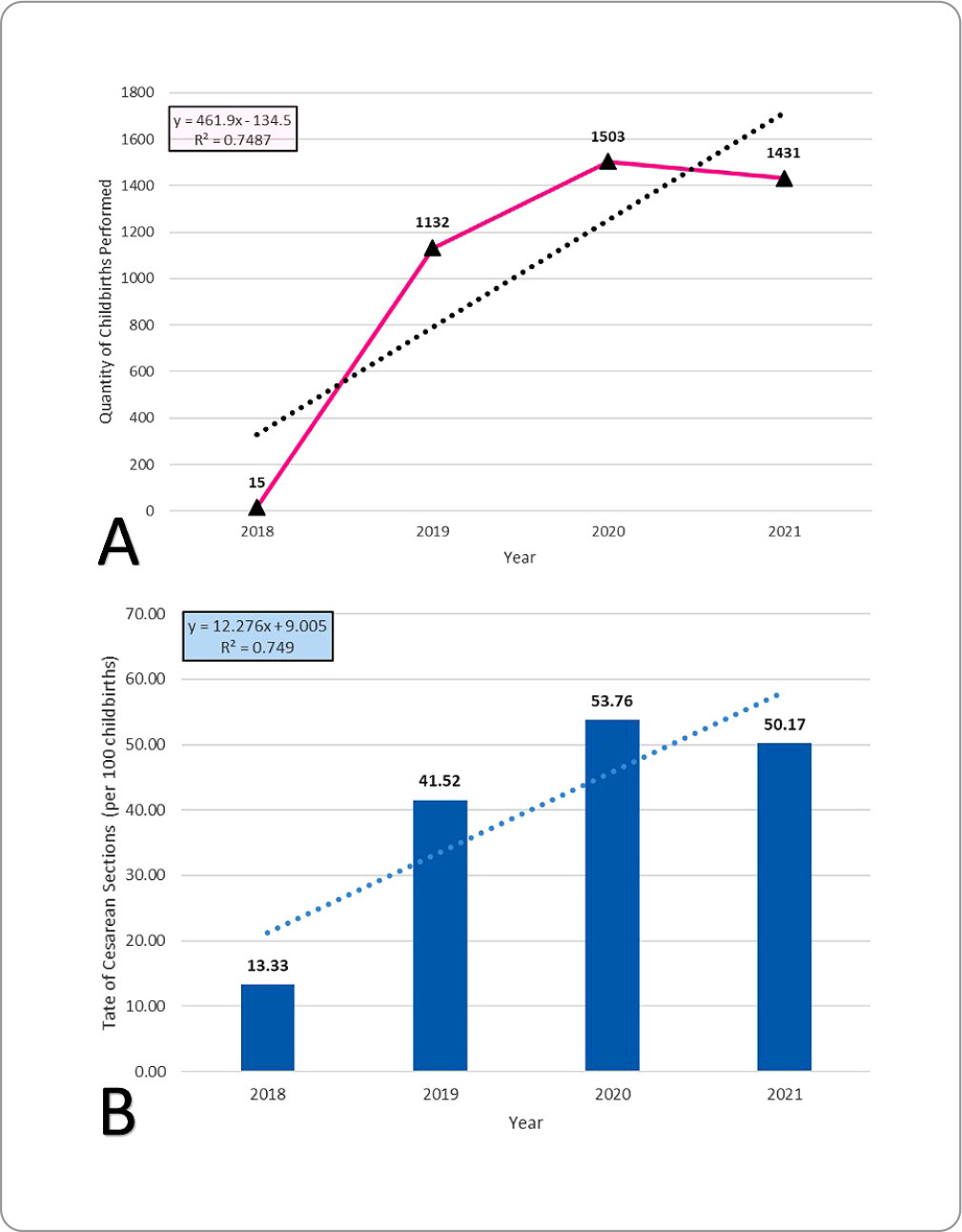
-
REVIEW01-10-2024
Nurses’ practical contributions to improving healthy and sustainable public spaces: an integrative review
Revista Brasileira de Enfermagem. 2024;77:e20240023
Abstract
REVIEWNurses’ practical contributions to improving healthy and sustainable public spaces: an integrative review
Revista Brasileira de Enfermagem. 2024;77:e20240023
DOI 10.1590/0034-7167-2024-0023
Views0ABSTRACT
Objective:
to identify knowledge production about nurses’ contributions to improving healthy and sustainable public spaces.
Methods:
an integrative review carried out in February 2023 in electronic databases. Studies that answered the research question and that were available in full, in Portuguese, English and Spanish, were included.
Results:
a total of five articles were selected. The findings highlighted the importance of educational projects in the training of local managers and community autonomy; citizen participation and health promotion as ways to implement Sustainable Development Goal 11; nurses as facilitators of collective care; new health practices and modes of producing subjectivity; and use of public transportation, bicycles and/or walking in these spaces.
Final considerations:
there is a clear need for greater incentives from local governments to develop effective sustainability strategies that are led by nurses and the community.
Keywords:AttitudesCommunity HealthHealth KnowledgeHealthy Lifestyle, NursesNursesPracticeSustainable DevelopmentSee more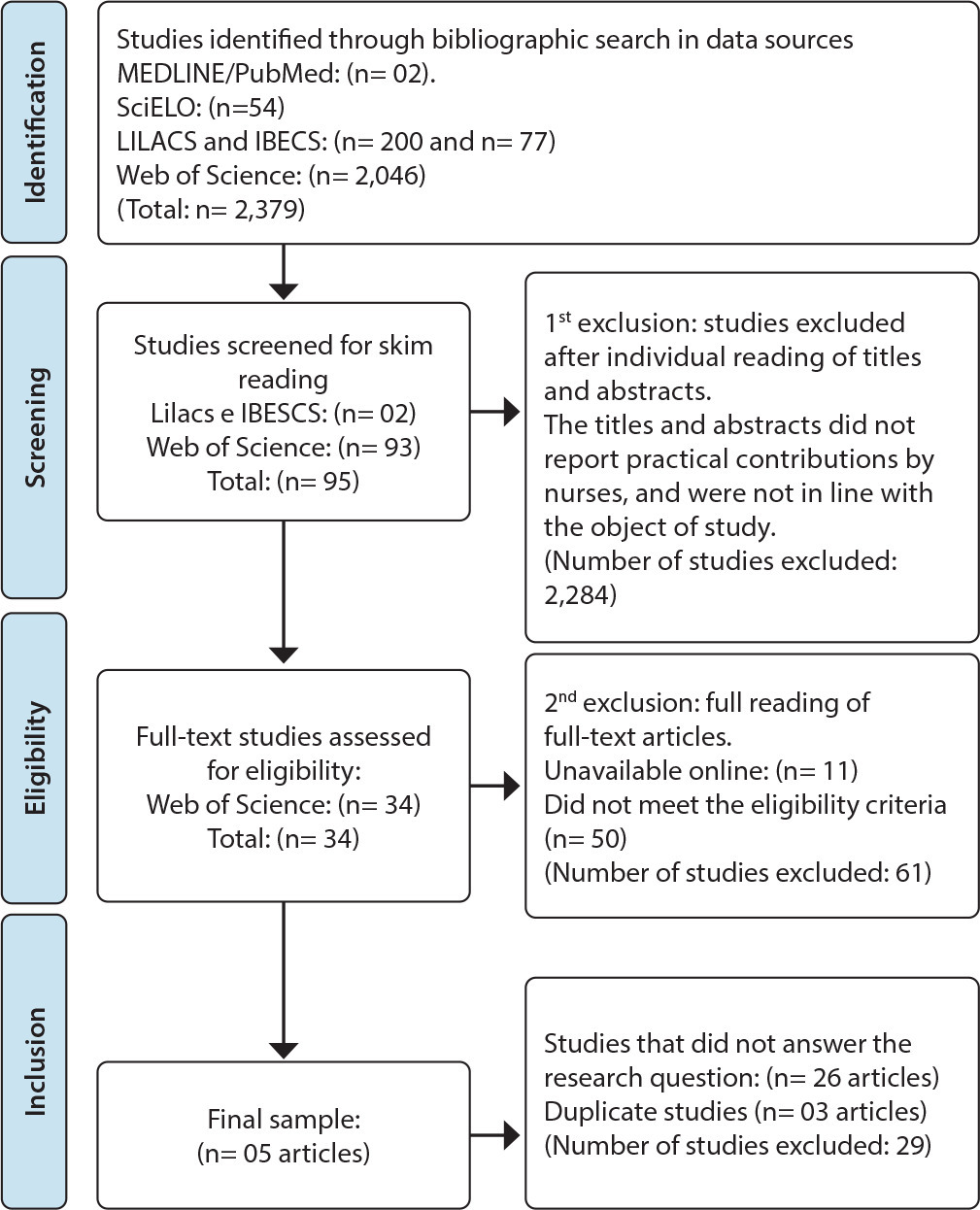
-
ORIGINAL ARTICLE01-10-2024
Pain management in hospitalized infants: recommendations for achieving the Sustainable Development Goals
Revista Brasileira de Enfermagem. 2024;77:e20230421
Abstract
ORIGINAL ARTICLEPain management in hospitalized infants: recommendations for achieving the Sustainable Development Goals
Revista Brasileira de Enfermagem. 2024;77:e20230421
DOI 10.1590/0034-7167-2023-0421
Views0See moreABSTRACT
Objective:
to assess pain management in infants in a Neonatal Intensive Care Unit (NICU) and discuss its articulation with the Sustainable Development Goals, with a focus on promoting neonatal well-being.
Method:
a documentary study, retrospective in nature and quantitative approach, conducted in a NICU of a public hospital in Paraná, Brazil, between January and July 2022, with 386 medical records of infants, hospitalized for more than 24 hours, between 2019 and 2021. Data were subjected to descriptive and inferential analysis, considering p-value<0.05 as a statistical difference. National ethical guidelines were respected.
Results:
all infants underwent at least one painful procedure, but only 13.7% had documented pain. Pharmacological interventions, such as fentanyl (25.9%), and non-pharmacological interventions, such as breastfeeding encouragement (86%) were used. Only 2.8% were reassessed.
Conclusion:
there was a devaluation of neonatal pain management that may perpetuate neonatal well-being and sustainable development.
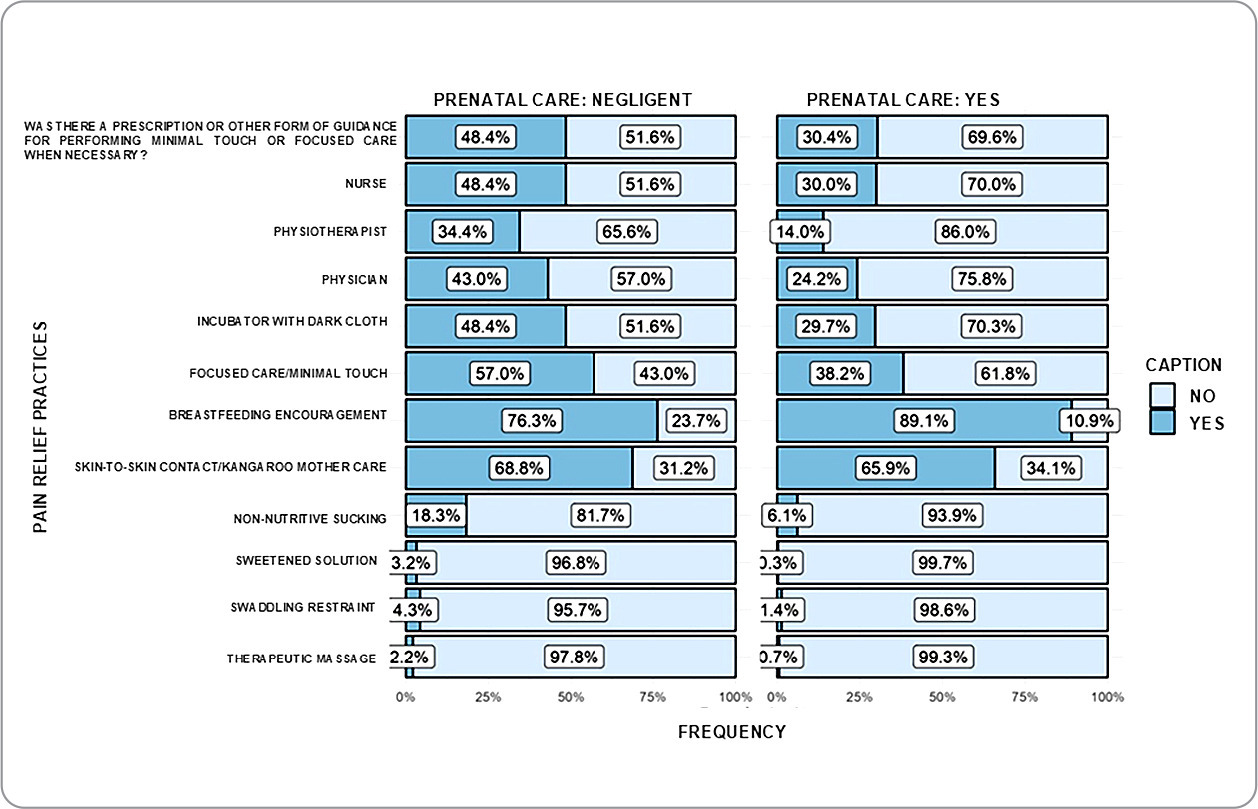
-
LETTER TO THE EDITOR01-10-2024
Adherence to COVID-19 vaccination during the pandemic and fake news: Correspondence
Revista Brasileira de Enfermagem. 2024;77:e202477Suppl101c
Abstract
LETTER TO THE EDITORAdherence to COVID-19 vaccination during the pandemic and fake news: Correspondence
Revista Brasileira de Enfermagem. 2024;77:e202477Suppl101c
-
LETTER TO THE EDITOR01-10-2024
Adherence to COVID-19 vaccination during the pandemic and fake news: Correspondence
Revista Brasileira de Enfermagem. 2024;77:e202477Suppl101c
Abstract
LETTER TO THE EDITORAdherence to COVID-19 vaccination during the pandemic and fake news: Correspondence
Revista Brasileira de Enfermagem. 2024;77:e202477Suppl101c
DOI 10.1590/0034-7167.202477Suppl101c
Views0Dear Dr Dulce Aparecida BarbosaEditor in Chief of the Revista Brasileira de Enfermagem[…]See more -
ORIGINAL ARTICLE01-10-2024
Clinical and epidemiological characteristics and outcomes of patients affected by COVID-19 in the Intensive Care Unit
Revista Brasileira de Enfermagem. 2024;77:e20230527
Abstract
ORIGINAL ARTICLEClinical and epidemiological characteristics and outcomes of patients affected by COVID-19 in the Intensive Care Unit
Revista Brasileira de Enfermagem. 2024;77:e20230527
DOI 10.1590/0034-7167-2023-0527
Views0See moreABSTRACT
Objective:
To understand the clinical and epidemiological characteristics, outcomes, and nursing care of adult patients affected by COVID-19 in the Intensive Care Unit.
Methods:
This is a quantitative, retrospective, and descriptive study. The study participants were clinical and epidemiological statistical reports. Variables analyzed included age, gender, race, comorbidities, signs and symptoms, length of hospital stay, use of mechanical ventilation, medications, infections, monitoring, invasive devices, positioning, diet, comfort, and clinical outcomes.
Results:
The majority of individuals were men, of white race, with a mean age of 63 years, hypertensive, diabetic, and obese. The average length of hospital stay was 16 days. Most required invasive mechanical ventilation, vasopressor drugs, sedoanalgesia, and neuromuscular blockers.
Conclusion:
Nursing care is related to monitoring, ventilation, medication administration, installation of devices, prone positioning, diet administration, and providing comfort.
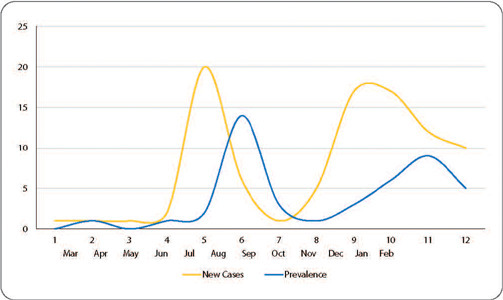
-
ORIGINAL ARTICLE01-10-2024
Morbidity and factors associated with frailty in post-COVID-19 elderly patients attended at a reference center
Revista Brasileira de Enfermagem. 2024;77:e20230454
Abstract
ORIGINAL ARTICLEMorbidity and factors associated with frailty in post-COVID-19 elderly patients attended at a reference center
Revista Brasileira de Enfermagem. 2024;77:e20230454
DOI 10.1590/0034-7167-2023-0454
Views0See moreABSTRACT
Objective:
To assess the morbidity profile and identify factors associated with frailty syndrome in post-COVID-19 elderly patients treated at the only Reference Center for Elderly Health Care in northern Minas Gerais.
Methods:
This is a case series study, utilizing the Clinical-Functional Vulnerability Index-20 (CFVI-20) and Comprehensive Geriatric Assessment (CGA) to characterize and evaluate the health condition of the group. To define the variables associated with frailty, a multivariate analysis was conducted.
Results:
The study included 204 elderly individuals, with a predominance of females (63.7%). The variables associated with frailty were cognitive impairment (OR: 2.95; 95% CI: 1.12-7.80; p=0.029), the presence of five or more comorbidities (OR: 11.55; 95% CI: 2.22-60.01; p=0.004), and impairment in instrumental activities of daily living (OR: 41.97; 95% CI: 5.47-321.93; p<0.001).
Conclusions:
The results of this study highlight the need for a well-established and prepared coordination of integrated care to meet the demands of the post-COVID-19 elderly population.
-
ORIGINAL ARTICLE01-10-2024
Nursing care management strategies to address the COVID-19 pandemic
Revista Brasileira de Enfermagem. 2024;77:e20230254
Abstract
ORIGINAL ARTICLENursing care management strategies to address the COVID-19 pandemic
Revista Brasileira de Enfermagem. 2024;77:e20230254
DOI 10.1590/0034-7167-20230254
Views0See moreABSTRACT
Objective:
To characterize nursing care management strategies for addressing the COVID-19 pandemic.
Method:
A descriptive, qualitative study conducted with 22 nurse professionals at a University Hospital in Southern Brazil. Data collection through interviews in June and August 2021, analyzed according to Bardin’s Content Analysis and the theoretical framework of complex thinking.
Results:
The identified strategies were organized into four categories: Reorganization of health services; People management and emergency admission; Multiprofessional articulation; and Bedside nursing care.
Final Considerations:
Professional performance revealed a complex interplay between leadership and care management practices, even in the face of working condition restrictions, and were understood as crucial in the pandemic scenario.
Search
Search in:
Nuvem de Tags
Aged (144) Atenção Primária à Saúde (239) COVID-19 (104) Cuidados de Enfermagem (269) Educação em Enfermagem (151) Educação em Saúde (139) Enfermagem (930) Estudos de Validação (131) Health Education (144) Idoso (208) Mental Health (149) Nursing (987) Nursing Care (306) Patient Safety (151) Primary Health Care (284) Qualidade de Vida (104) Quality of Life (106) Saúde Mental (145) Segurança do Paciente (150) Validation Studies (108)




